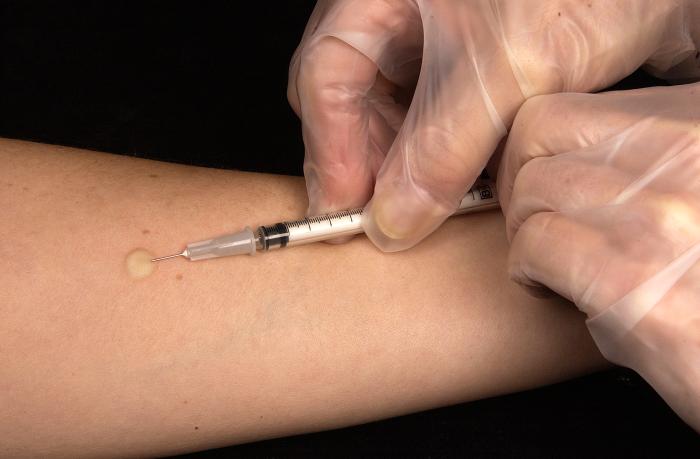-
"This web page was produced as an assignment for an undergraduate course at Davidson College."

Photograph of TB Skin Test from CDC website
Recognition:
Identification methods of Tuberculosis infection:
- TB- skin test- This has been used as a sign of infection or response to the BCG vaccination. Patients are challenged with PPD (purified protein derivative) typically by a shot in the forearm. If a patient reacts with PPD, a reddish bump will appear at the sight of injection (Boshoff 2005).
- Chest X-Ray- When patients test postive for PPD, patients are then typically assesd via X-ray to monitor the disease. Often in a latent stage, granulomatous structures appear in the mid-region of the lung and in the draining lymph node (Boshoff 2005).
- Culture/ Bacterial Smear
Vaccine
BCG (Bacille Calmette-Guerin)— The vaccine is named for its creators Albert Calmetter and Camille Guerin, who began developing a TB vaccine began in 1908. The first vaccine was adminstered in 1921. The BCG was developed by culturing M. bovis, and since 1921 more than one billion individuals have been innoculated with BCG. This is a widely controversial vaccine because of extremely variant results from no protection to excellent protection (Aeras 2004).
Currently more vaccines are being developed.
Treatment: Chemotherapy
TB drugs are often given in combination to elicit two important properties: antibacterial activity and capacity to inhibit the onset of resistance. Treatment usually consist of two phases: an intial two month treatment period and then a follow up treatment period of four to seven months. Exact treatment protocols and drugs perscribed vary from patient to patient (Treatment 2003).
Important antibacterial drugs are: isoniazid, rifampin, and streptomycin (Areas 2004).
Important inhibiters of the development of resistance: isoniazid, rifampin, and ethambutol
Other secondary medications include: ethinoamide, protisonamide, pyrazinamide, cycloserine, caperomycin, viomycin, and kanamycin
Problems:
Combined with HIV
HIV targets and depletes CD4+ T-cells (Janeway 2005). CD4+ T-cells especially TH1 cells are crucial in host response of eliminating or at least controlling a TB infections. As a result, hosts with HIV are more susceptible to all mycobacterial infections including tuberculosis (Wangoo 2001).
As a result, TB is main cause of death in HIV patients, projected at killing about half of the HIV positive population. According to the World Health Organization approxiamtely one-third of the world’s HIV population also is infected with TB. In addition, people with HIV are approxiamtely fifty times more likely to contract and develop TB than individuals without HIV (WHO 2007). These effects are apparent in sub-sharan africa where since the mid-1980s, the onset of the HIV epidemic, annual reported TB infections have risen approximately 400 percent (Areas 2004).
Additionaly in HIV positive individuals: (1) it is harder to diagnose TB; (2) TB spreads faster, (3) TB is fatal if left undiagnosed (in an HIV positive individual), and (4) HIV surfaces earlier in the disease progression of HIV (WHO 2007).
RESISTANT STRAINS
MDR-TB
Multi-drug resistant TB is is “resistant to at least isoniazid and rifampicin, the two most powerful first-line antie TB drugs.” Effective treatment of TB becomes more difficult (WHO 2007).
XDR-TB
Extreme drug resistant TB is “resistant to at least isoniazid and rifampicin, the two most powerful first-line antie TB drugs” plus additional resistance to (i) any fluoroquinolone, and (ii) at least 1 of 3 injectable second-line drugs capreomycin, kanamycin, or amikacin. XDR-TB has been found in 35 countries including Lativa, South Korea, South Africa. and the United States (WHO 2007).
Future Directions: WHO STOP TB STRATEGY and THE Global Plan

Picture reproduced from the NIH
The World Health Organization first launched a program entitled International Union Against Tuberculosis and Lung Disease in 1994 in response to the first emergence of MDR-TB (Zignol 2006).
Now, the World Health Organization has enacted a 6 point plan to eliminate TB as a public health concern by 2050. This was enacted in 2006 and is projected to treat 50 million patients and save 14 million lives by 2015. More can be read about the plan and strategies of the World Health Organization at their online website (WHO 2007).
This site was created as partial fulfillment of requirments for Biology 323 at Davidson College in the Spring Semster of 2006.
Davidson Home Davidson Biology Home
Questions and comments should be directed to Dr.Sarafova or to the site creator Emily Rivard